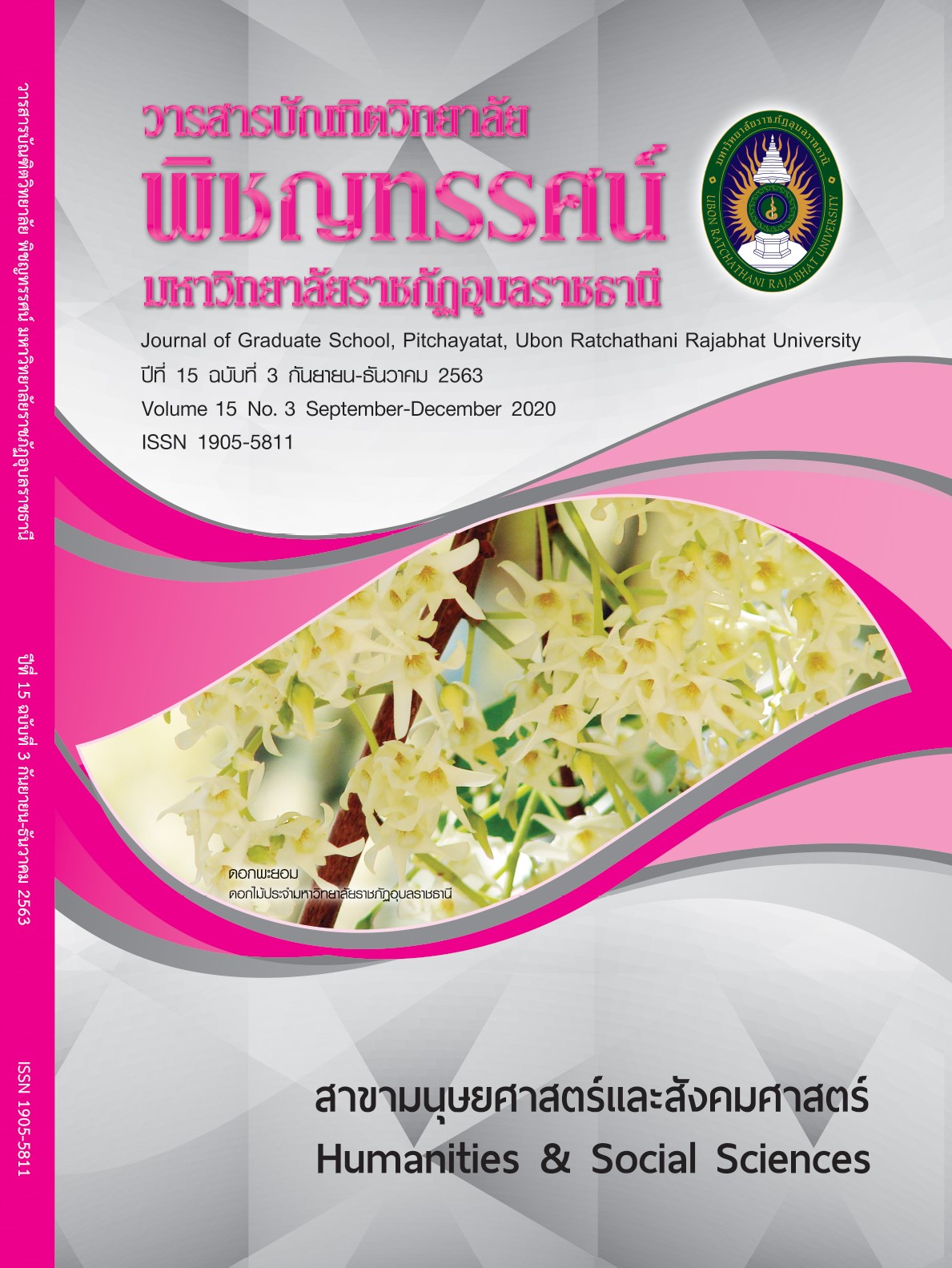การพัฒนารูปแบบการจัดการเรียนรู้ตามแนวคิดบูรณาการศาสตร์ เรื่องโครงงานคอมพิวเตอร์ เพื่อสร้างเสริมความคิดสร้างสรรค์ สำหรับนักเรียนระดับชั้นมัธยมศึกษาปีที่ 3
คำสำคัญ:
การจัดการเรียนรู้บูรณาการศาสตร์, โครงงานคอมพิวเตอร์, ความคิดสร้างสรรค์บทคัดย่อ
การวิจัยนี้มีวัตถุประสงค์เพื่อ 1) ศึกษาองค์ประกอบของรูปแบบการจัดการเรียนรู้ตามแนวคิดบูรณาการศาสตร์เรื่องโครงงานคอมพิวเตอร์ เพื่อสร้างเสริมความคิดสร้างสรรค์ สำหรับนักเรียนระดับชั้นมัธยมศึกษาปีที่ 3 2) พัฒนารูปแบบการจัดการเรียนรู้ตามแนวคิดบูรณาการศาสตร์ เรื่องโครงงานคอมพิวเตอร์ เพื่อสร้างเสริมความคิดสร้างสรรค์ สำหรับนักเรียนระดับชั้นมัธยมศึกษาปีที่ 3 3) ศึกษาผลการใช้รูปแบบการจัดการเรียนรู้ตามแนวคิดบูรณาการศาสตร์ เรื่องโครงงานคอมพิวเตอร์ เพื่อสร้างเสริมความคิดสร้างสรรค์ สำหรับนักเรียนระดับชั้นมัธยมศึกษาปีที่ 3 ตัวอย่างที่ใช้ ได้แก่ ครูผู้สอนที่มีความรู้และประสบการณ์เกี่ยวกับการจัดการเรียนรู้แบบบูรณาการศาสตร์ จำนวน 200 คน และนักเรียนชั้นมัธยมศึกษาปีที่ 3 โรงเรียนสระแก้วรัตนวิทย์ จำนวน 30 คน ซึ่งได้มาจากการสุ่มอย่างง่าย สถิติที่ใช้ได้แก่ ร้อยละ ค่าเฉลี่ย ส่วนเบี่ยงเบนมาตรฐาน และการทดสอบที
ผลการวิจัยพบว่า
- ผลการศึกษาองค์ประกอบของรูปแบบการจัดการเรียนรู้ตามแนวคิดบูรณาการศาสตร์ เรื่องโครงงานคอมพิวเตอร์ เพื่อสร้างเสริมความคิดสร้างสรรค์ สำหรับนักเรียนระดับชั้นมัธยมศึกษาปีที่ 3 ประกอบด้วย 5 องค์ประกอบ ได้แก่ 1) หลักการ 2) วัตถุประสงค์ 3) เนื้อหา 4) กระบวนจัดการเรียนรู้ และ 5) การวัดและประเมินผล
- ผลการพัฒนารูปแบบการจัดการเรียนรู้ตามแนวคิดบูรณาการศาสตร์ เรื่องโครงงานคอมพิวเตอร์เพื่อสร้างเสริมความคิดสร้างสรรค์ สำหรับนักเรียนระดับชั้นมัธยมศึกษาปีที่ 3 โดยทุกองค์ประกอบของรูปแบบการจัดการเรียนรู้มีความเหมาะสม มีค่าเฉลี่ย .84
- ผลการใช้รูปแบบการจัดการเรียนรู้ พบว่าผลการทดสอบวัดความคิดสร้างสรรค์หลังเรียนของผู้เรียนสูงกว่าก่อนเรียน อย่างมีนัยสำคัญทางสถิติที่ระดับ .05
คำสำคัญ: การจัดการเรียนรู้บูรณาการศาสตร์ โครงงานคอมพิวเตอร์ ความคิดสร้างสรรค์
เอกสารอ้างอิง
องค์การรับส่งสินค้าและพัสดุภัณฑ์, 2542.
จุติพร อัศวโสวรรณ และคณะ. “การพัฒนารูปแบบการเรียนการสอนแบบบูรณาการโดยการจัดประสบการณ์ตาม
แนวคิดคอนสตรัคติวิสต์เพื่อพัฒนาการคิดวิเคราะห์และผลสัมฤทธิ์ทางการเรียนนักเรียนชั้นประถมศึกษา
ปีที่ 3,” วารสารมหาวิทยาลัยนราธิวาสราชนครินทร์. 5, 3 (กันยายน 2556): 81-93.
ชุลีพร อร่ามเนตร. “ไขคำตอบ โรงเรียน-ครู อยู่อย่างไรในยุค 4.0,” คมชัดลึก. 14 (กุมภาพันธ์ 2560): 10.
พิชญ์สินี ชมภูคำ. การสอนโครงงานด้วยการบูรณาการสาระการเรียนรู้กับวิถีไทยโดยใช้สถิติเป็นฐาน สำหรับ
ครูผู้สอนระดับมัธยมศึกษาตอนต้น. เชียงใหม่: มหาวิทยาลัยราชภัฏเชียงใหม่, 2554.
มณฑา ชุ่มสุคนธ์. “การพัฒนาการเรียนการสอนแบบบูรณาการในรายวิชาของสาขาวิชาสังคมศึกษาระดับปริญญาตรี
ที่ส่งเสริมการเรียนการสอนที่เน้นผู้เรียนเป็นสำคัญ,” วารสารวิชาการ. 7, 1 (มกราคม 2557): 1-2.
วิทยากร เชียงกูล. รายงานสภาวะการศึกษาไทย ปี2557/2558 “จะปฏิรูปการศึกษาไทยให้ทันโลกในศตวรรษที่
21 ได้อย่างไร”. กรุงเทพฯ: โรงพิมพ์คุรุสภาลาดพร้าว, 2559.
ศุภักษร ฟองจางวาง. “การศึกษาองค์ประกอบของรูปแบบการเรียนการสอนแบบผสมผสานโดยใช้การเรียนรู้แบบร่วมมือ เรื่องการเขียนโปรแกรมขั้นพื้นฐานด้วยภาษาจาวาสคริปต์สำหรับนักเรียนชั้นมัธยมศึกษาปีที่ 3,” วารสารวิชาการมหาวิทยาลัยศิลปากร. 9, 3 (กันยายน 2559):1.
สถาพร พฤฑฒิกุล. “คุณภาพผู้เรียน เกิดจากกระบวนการเรียนรู้,” วารสารการบริหารการศึกษามหาวิทยาลัยบูรพา. 6, 2 (เมษายน 2555) :3.
สิริพัชร์ เจษฎาวิโรจน์. “การจัดการเรียนรู้แบบบูรณาการสิ่งที่ครูทำได้ไม่ยากจริง ๆ,” วารสารวิชาการ. 9, 1 (มิถุนายน 2549): 63-71.
สุภัทรา ภูษิตรัตนาวลี. “รูปแบบการจัดการเรียนรู้เชิงรุกสําหรับคณาจารย์วิทยาลัยเทคโนโลยีภาคใต้,” วารสาร
เทคโนโลยีภาคใต้. 2, 3 (มกราคม 2560): 154-157.
หิรัณย์ ศุภวนนิมิต. การพัฒนารูปแบบการจัดการเรียนรู้แบบบูรณาการเพื่อพัฒนาทักษะกระบวนการแก้ปัญหา
ของนักเรียนระดับประกาศนียบัตรวิชาชีพ ชั้นปีที่ 3 สาขาวิชาไฟฟ้า. แผนกวิชาไฟฟ้ากำลังภาควิชาอุตสาหกรรม: วิทยาลัยเทคโนโลยีปัญญาภิวัฒน์, 2557.
ดาวน์โหลด
เผยแพร่แล้ว
รูปแบบการอ้างอิง
ฉบับ
ประเภทบทความ
สัญญาอนุญาต
บทความทุกเรื่องได้รับการตรวจความถูกต้องทางวิชาการโดยผู้ทรงคุณวุฒิภายนอกอย่างน้อย 2 คน ความคิดเห็นในวารสารบัณฑิตวิทยาลัย พิชญทรรศน์ มหาวิทยาลัยราชภัฏอุบลราชธานี เป็นความคิดเห็นของผู้เขียนมิใช่ความคิดเห็นของผู้จัดทำ จึงมิใช่ ความรับผิดชอบของบัณฑิตวิทยาลัย มหาวิทยาลัยราชภัฏอุบลราชธานี และบทความในวารสารบัณฑิตวิทยาลัย พิชญทรรศน์ มหาวิทยาลัยราชภัฏอุบลราชธานี สงวนสิทธิ์ตามกฎหมายไทย การจะนำไปเผยแพร่ต้องได้รับอนุญาตเป็นลายลักษณ์อักษรจากกองบรรณาธิการ






